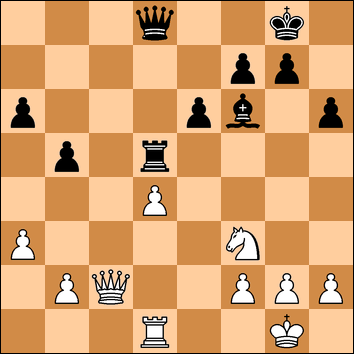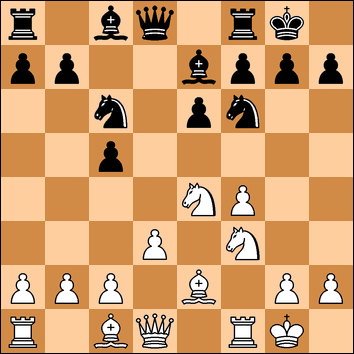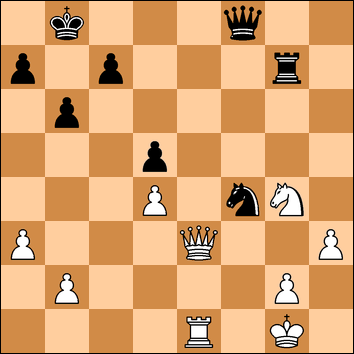Swale Club Chess Championship - Round Eleven
Thursday 23 January 2020
White: Keith Nevols (157) - Black: Dennis Simpson (134)
Queen's Gambit Declined
My opponent here is famed in the club for his defensive skills so I knew it would be a struggle. I decided to open on the 'left' and play a Queen's Gambit Declined in the hope of gaining a positional advantage.
My opponent here is famed in the club for his defensive skills so I knew it would be a struggle. I decided to open on the 'left' and play a Queen's Gambit Declined in the hope of gaining a positional advantage.
1. d4 Nf6
2. c4 e6
3. Nc3 d5
4. Bg5 Be7
5. e3 O-O
6. Nf3 a6!?
2. c4 e6
3. Nc3 d5
4. Bg5 Be7
5. e3 O-O
6. Nf3 a6!?
An interesting plan. 6. .... h6 is considered to be best putting the question to the White bishop. The recommendation for White is now 7. cxd5 exd5 8. Bd3 taking the b1-h7 diagonal. This is proof of my unfamiliarity with this opening.
7. Be2?! dxc4
8. Bxc4 b5
9. Be2 Bb7
Black has equalised and is ready to expand on the queenside.
10. O-O Nbd7
11. a3 c5
12. Qb3?
11. a3 c5
12. Qb3?
White has to play 12. dxc5 Nxc5 and then choose between 13. b4, 13. Rc1 or 13. Qxd8. I was keen to put a rook on d1 but the queen is misplaced here.
12. .... cxd4
13. exd4?!
13. exd4?!
13. Nxd4 is better as now this pawn is isolated and easy to blockade.
13. ....... Nb6
Throughout Black has been reluctant to play .. h6 and here 13. .. h6 could be followed by Rc8.
14. Rfd1 Nbd5
15. Bxf6
15. Bxf6
Part of a plan to neutralise the bishop on b7.
15. .......Nxf6
16. Ne5 Rc8
17. Bf3 Bxf3
18. Nxf3 Qb6!
16. Ne5 Rc8
17. Bf3 Bxf3
18. Nxf3 Qb6!
Despite the exchange of the b7 bishop, Black is better now. However the game looks colourless and I still could not see how I could get an advantage. My queen is still misplaced and Black has no clear weaknesses.
19. Rd2 Rfd8
20. Re1
20. Re1
With my eye on the e6 square and aiming to get the queen in the game.
20. ..... h6
21. Rde2 Nd5
22. Re4? Nf6?
21. Rde2 Nd5
22. Re4? Nf6?
Missing 22. .. Nxc3 23. bxc3 Qa5 winning a pawn. It is possible that White was concerned about 24. Rxe6 (24. .... fxe6 25. Qxe6+ Kh8 (25. ... Kf8??? 26, Ne5 mates next move) 26. Ne5 which should force a draw) but Black can answer with 24. .. Rxc3!.
23. Re2
This time 23. Rxe6 works. 23. .... fxe6 24. Rxe6 Qc7 25. Rc6+ Kh8 26. Rxc7 Rxc7 but there is still a lot of work to do.
23. ......Nd5
24. Rd2 Rc4?
24. Rd2 Rc4?
24. .. Nxc3 25. bxc3 Qa5 still wins a pawn.
25. Red1 Nf6?
26. Re1 Nd5
27. Nxd5
Breaking the tension and eliminating the much overlooked Nxc3 option.
27. ..... Rxd5
28. Rc2 Rxc2
29. Qxc2 Bf6
30. Rd1 Qd8
And, to my surprise, Black offered a draw which I grabbed.
28. Rc2 Rxc2
29. Qxc2 Bf6
30. Rd1 Qd8
And, to my surprise, Black offered a draw which I grabbed.
Black can win a pawn with the immediate threat of e5 and the use of White's weak bank rank.
For example, if 31. Qe4 e5 or if 31. g3 Bxd4 32. Nxd4 Rxd4 33. Rxd4 Qxd4 34. Qc8+ Kh7 35. Qxa6 Qxb2 - Black is a pawn up but has work to do while White would face a grim defence.















